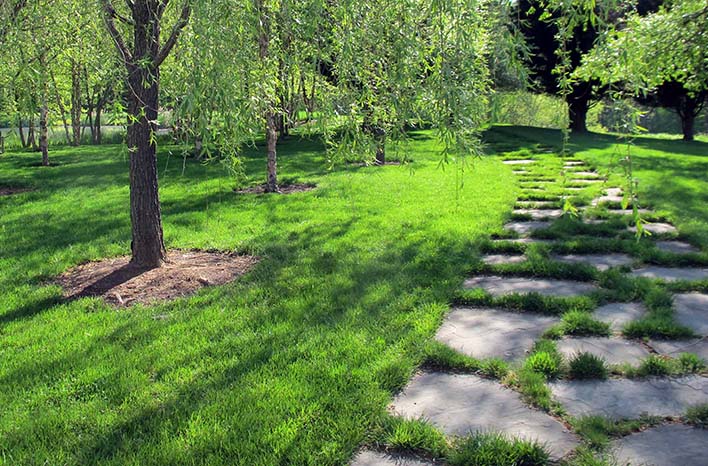Steps to a Beautiful Organic Lawn

Creating a lush and sustainable organic lawn is a rewarding endeavour that involves a series of key steps. Begin by assessing your soil's health and addressing any imbalances, ensuring it provides the ideal foundation for your grass. Choose grass varieties suited to your region and soil type, promoting resilience and low water requirements. Embrace organic fertilization, mowing practices, and watering techniques to encourage natural growth and minimize environmental impact. Finally, adopt eco-friendly pest control methods and weed management strategies to nurture a beautiful, chemical-free lawn that's both visually appealing and ecologically responsible.
Five steps to an organic lawn you’ll love - Here are five steps to implement a healthy regimen that satisfies and rewards in all the right ways.
Get a soil test - The information that this test provides can help ensure that you are doing all you can to promote your soil’s health. Healthy soil, in turn, provides the best long-term benefits to your lawn. Of all the important things a soil test will reveal, the main one I look to is the soil’s pH level. When this number is in the “ideal” range for growing grass, turf roots will be able to utilize nutrients already present, therefore minimizing the need to add anything further. Outside that range, and adding more chemicals will not only not help matters, it may make conditions worse. The magic number? Somewhere between 6.5 and 7.0. Getting your soil’s pH level within that ideal range is a key factor to how lush your lawn is. And a soil test tells you how to get there. Call your county extension service for the soil test kit and additional information.
Clean up - I prefer to have a clean surface to work with before I add any product to my lawn. Thatch, leaf debris, and weeds can prevent soil amendments from making their way on or into the soil. A stiff rake and a little bit of elbow grease is usually all it takes to prep the lawn surface. Collect what you scratch up and add it to your compost.
Aerate - A clean surface also paves the way for the probes of a tool called a core aerator. This piece of equipment extracts plugs (cores) of soil from the ground. These extracted cores relieve soil compaction by allowing more room in the ground for root expansion, oxygen exchange, and drainage. The small holes left behind after aerating also collect and hold soil amendments or fertilizer in place. Yes, a yard full of extracted plugs looks messy. But it’s temporary. Within a few days, the cores will have washed back into the ground, having done their job. Aerating is a very helpful step, but not one that is mandatory. Since a core aerator is a tool that sees one afternoon of work a year, it likely makes more sense to rent one than to purchase one and store it for the other 364 days.
Feed the soil - Nearly all grass types (centipedegrass and buffalograss are two common exceptions) are heavy feeders. I use two main products. And unlike synthetic fertilizers, both build soil health while feeding the lawn naturally.
Compost - It’s full of all the nutrients a lawn needs and includes lots of other beneficial ingredients that are important to building long-term soil and lawn health. A little bit of compost goes a long way, but you’ll still want to add at least a half-inch across the entire lawn surface. For most yards, that can quickly exhaust your homemade compost supply and likely an impractical option for buying bagged compost. Instead, find a reputable bulk supplier that offers “STA Certified Compost.” This designation represents the Seal of Testing Assurance, which is issued by the US Composting Council.* Products carrying the STA designation have been analyzed for ten important criteria of quality compost.
Milorganite - When it comes to bagged fertilizer, this is my go-to, especially for lawns. It’s an organic, non-burning, slow-release nitrogen feeder with iron. Milorganite** works well at building a healthy lawn with good green color, and improves soil health, too. It features excellent consistency of its ingredients, is readily available, and is easy to apply with a rotary or drop spreader.
Mow and water less - Use the techniques listed above, and you’ll end up with a lush, green lawn- yes, one that requires periodic mowing, but not too much. In an organic lawn maintenance routine, you allow your grass to grow to the upper height of its preferred range. This will result in more vigorous turf with deeper roots and fewer weeds, as taller blades will shade and outcompete weeds vying for the same space. Another advantage to organically managed lawns: better soil health promotes deeper roots and better water retention capacity. Bottom line, they’re more drought-tolerant and require less supplemental irrigation.
Lawn Maintenance Services
Experience top-notch lawn care services at affordable prices with Lawnber. Our local lawn care experts are here to make your lawn beautiful and healthy. Schedule your service today!
Student Appartment Rent
Are you a college student in search of the perfect blend of affordable homes and quality living spaces in the bustling city of New York? Look no further than NYUSRent – your go-to platform for cheap rent, good rooms, and 1B1B or 1BHK apartments that fit your budget without compromising on comfort. Book Now!